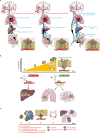Where Are We Now and Where Might We Be Headed in Understanding and Managing Brain Metastases in Colorectal Cancer Patients?
- PMID: 35482170
- PMCID: PMC9174111
- DOI: 10.1007/s11864-022-00982-0
Where Are We Now and Where Might We Be Headed in Understanding and Managing Brain Metastases in Colorectal Cancer Patients?
Abstract
Opinion statement: Compared to liver and lung metastases, brain metastases (BMs) from colorectal cancer (CRC) are rare and remain poorly investigated despite the anticipated rise in their incidence. CRC patients bearing BM have a dismal prognosis with a median survival of 3-6 months, significantly lower than that of patients with BM from other primary tumors, and of those with metastatic CRC manifesting extracranially. While liver and lung metastases from CRC have more codified treatment strategies, there is no consensus regarding the treatment of BM in CRC, and their management follows the approaches of BM from other solid tumors. Therapeutic strategies are driven by the number and localisation of the lesion, consisting in local treatments such as surgery, stereotactic radiosurgery, or whole-brain radiotherapy. Novel treatment modalities are slowly finding their way into this shy unconsented armatorium including immunotherapy, monoclonal antibodies, tyrosine kinase inhibitors, or a combination of those, among others.This article reviews the pioneering strategies aiming at understanding, diagnosing, and managing this disease, and discusses future directions, challenges, and potential innovations in each of these domains.
Highlights: • With the increasing survival in CRC, brain and other rare/late-onset metastases are rising. • Distal colon/rectal primary location, long-standing progressive lung metastases, and longer survival are risk factors for BM development in CRC. • Late diagnosis and lack of consensus treatment strategies make BM-CRC diagnosis very dismal. • Liquid biopsies using circulating tumor cells might offer excellent opportunities in the early diagnosis of BM-CRC and the search for therapeutic options. • Multi-modality treatment including surgical metastatic resection, postoperative SRS with/without WBRT, and chemotherapy is the best current treatment option. • Recent mid-sized clinical trials, case reports, and preclinical models show the potential of unconventional therapeutic approaches as monoclonal antibodies, targeted therapies, and immunotherapy. Graphical abstract.
Keywords: Brain metastasis (BM); Colorectal cancer (CRC); Liquid biopsies; Metastatic pathways; Novel treatments.
© 2022. The Author(s).
Conflict of interest statement
Thibaud Koessler discloses consulting and advisory role for Merck Sharp@Dohme (MSD), BMS, Lilly, Roche, Boehringer Ingelheim, and Servie. He has also benefited from Travel grants by Lilly, Ipsen, and Sanofi. The remaining authors have declared no conflicts of interest in connection with this article.
Figures



Similar articles
-
Clinical features and prognostic factors of brain metastases from colorectal cancer: a single center experience.Int J Colorectal Dis. 2023 Jul 19;38(1):198. doi: 10.1007/s00384-023-04451-4. Int J Colorectal Dis. 2023. PMID: 37466736
-
Multidisciplinary management of colorectal brain metastases: a retrospective study.Cancer. 2008 Jul 1;113(1):158-65. doi: 10.1002/cncr.23531. Cancer. 2008. PMID: 18459179
-
Brain metastases from colorectal carcinoma: a description of 60 cases in a single Chinese cancer center.Tumour Biol. 2011 Dec;32(6):1249-56. doi: 10.1007/s13277-011-0229-7. Epub 2011 Sep 13. Tumour Biol. 2011. PMID: 21913132
-
Brain metastases from colorectal cancer: characteristics and management.ANZ J Surg. 2018 Mar;88(3):140-145. doi: 10.1111/ans.14107. Epub 2017 Jul 7. ANZ J Surg. 2018. PMID: 28687024 Review.
-
Systemic Therapy for Lung Cancer Brain Metastases.Curr Treat Options Oncol. 2021 Oct 25;22(12):110. doi: 10.1007/s11864-021-00911-7. Curr Treat Options Oncol. 2021. PMID: 34693454 Review.
Cited by
-
Crosstalk Between the Nervous System and Colorectal Cancer.Neurosci Bull. 2025 Jan;41(1):93-106. doi: 10.1007/s12264-024-01238-7. Epub 2024 Jun 16. Neurosci Bull. 2025. PMID: 38879846 Review.
-
Five-Fraction Radiosurgery Using a Biologically Equivalent Dose of a Single Fraction of 24 Gy for a 3-cm Parasagittal Para-Central Sulcus Brain Metastasis From Adenocarcinoma of the Cecum.Cureus. 2023 Nov 14;15(11):e48799. doi: 10.7759/cureus.48799. eCollection 2023 Nov. Cureus. 2023. PMID: 38098911 Free PMC article.
-
A case of dMMR/MSI-H/TMB-H colon cancer with brain metastasis treated with PD-1 monoclonal antibody.Zhejiang Da Xue Xue Bao Yi Xue Ban. 2024 Feb 15;53(1):58-63. doi: 10.3724/zdxbyxb-2023-0547. Zhejiang Da Xue Xue Bao Yi Xue Ban. 2024. PMID: 38413220 Free PMC article. Chinese, English.
-
Cerebellar metastasis from colorectal cancer: a case report.Front Oncol. 2025 Jan 24;15:1519441. doi: 10.3389/fonc.2025.1519441. eCollection 2025. Front Oncol. 2025. PMID: 39926284 Free PMC article.
-
Single-fraction SRS and multiple-fraction SRT for brain metastases from colorectal cancer.Front Oncol. 2022 Dec 6;12:1060570. doi: 10.3389/fonc.2022.1060570. eCollection 2022. Front Oncol. 2022. PMID: 36561523 Free PMC article.
References
References and Recommended Reading
Papers of particular interest, published recently, have been highlighted as: • Of importance •• Of major importance
Publication types
MeSH terms
Substances
LinkOut - more resources
Full Text Sources
Medical

